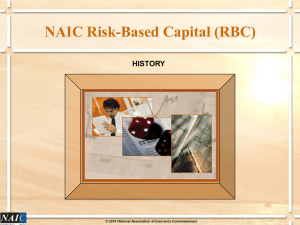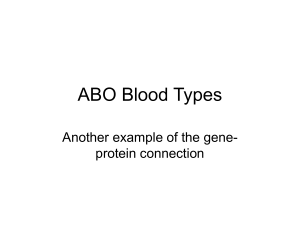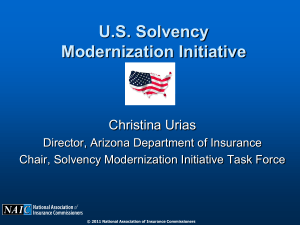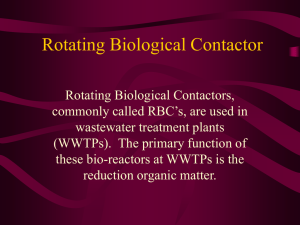What is RBC?
advertisement
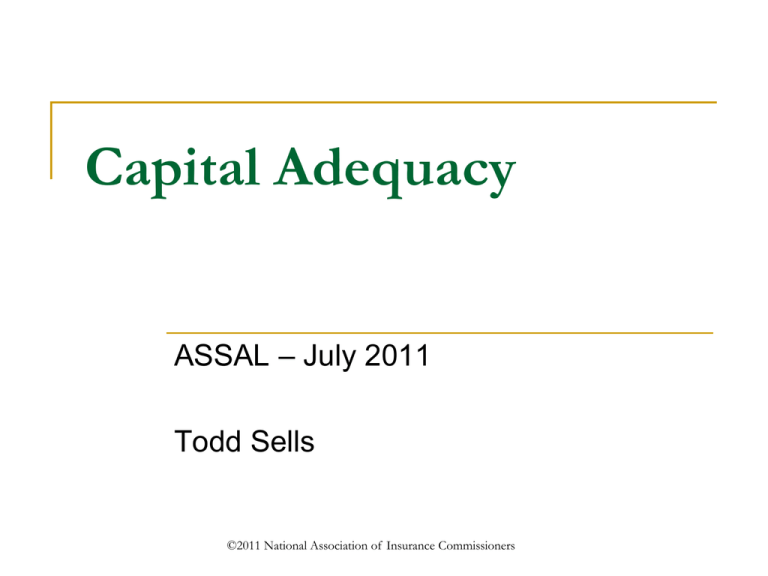
Capital Adequacy
ASSAL – July 2011
Todd Sells
©2011 National Association of Insurance Commissioners
Capital Adequacy
Fixed Minimum Capital & Surplus
Risk-Based Capital (RBC)
Surveillance - Financial Analysis
Future: Solvency Modernization Initiative (SMI)
includes the Own Risk & Solvency Assessment
(ORSA)
©2011 National Association of Insurance
Commissioners
Overview of RBC Formulas
©2011 National Association of Insurance
Commissioners
What is RBC?
RBC is a method of measuring the minimum
amount of capital appropriate for a reporting
entity to support its overall business
operations in consideration of its size and risk
profile
If an insurer holds capital and surplus below this
minimum, then a regulatory response is required
©2011 National Association of Insurance
Commissioners
Overview of RBC
Account for a company’s risk exposure
Adjusts minimum capital & surplus
requirements accordingly
Reflects unique risks inherent in operating an
insurance company
The formula considers the entity’s size, structure
and risk profile.
©2011 National Association of Insurance
Commissioners
NAIC RBC System
Four formulas: Life, Fraternal, P & C, and
Health
Risk-Based Capital for Insurers Model Act
serves as a guide
RBC law in each state makes system
operational
NAIC produces formula but regulatory power
resides with the state
©2011 National Association of Insurance
Commissioners
Overview of RBC
RBC provides capital adequacy standards
that:
Relate to risk
Raise a safety net for insurers
Are uniform among states
Provide regulatory authority for timely action
©2011 National Association of Insurance
Commissioners
RBC Formula
Not all risks accounted for
Each component of formula not material to all
companies
Not totally accurate for all companies but
reasonably accurate for most companies
To be effective, must be applied uniformly
across all states
©2011 National Association of Insurance
Commissioners
RBC is NOT:
An Early Warning Device
Designed to Prevent Insolvency
Designed to Detect Fraud
A Stand-Alone Tool for Solvency Monitoring
Designed to Fit Every Scenario and Capture
Every Possible Risk
©2011 National Association of Insurance
Commissioners
Misconceptions About RBC
It is a misconception that RBC……
will help predict insolvency
is an indicator of financial strength
Keep in mind that RBC calculations are kept
confidential, though the results are public
©2011 National Association of Insurance
Commissioners
Capital Standards
Important Component of Solvency Regulation
Capital = Assets (What an Insurer Owns)
minus Liabilities (What an Insurer Owes)
Insurers with higher risks carry higher capital
If insurer’s capital falls below minimum,
considered legally impaired
Tradeoff Between Insolvency Costs and
Prevention Costs
©2011 National Association of Insurance
Commissioners
Risk-Based Capital for Insurers Model Act
Structure of RBC Model Acts
Section 1 – Definitions
Section 2 – RBC
Reports
Section 3 – Company
Action Level Event
Section 4 – Regulatory
Action Level Event
Section 5 – Authorized
Control Level Event
Section 6 – Mandatory
Control Level Event
Section 10 – Foreign
Organizations
Section 7 – Hearings
Section 11 –
Immunity
Section 8 –
Confidentiality; Prohibition
on Announcements;
Prohibition on use in Rate
Making
Section 9 – Supplemental
Provisions, Rules,
Exemptions
©2011 National Association of Insurance
Commissioners
Section 12 –
Severability Clause
Section 13 – Notices
Section 14 – Phase
in Provision
Section 15 –
Effective Date
Overview of RBC Model Laws
(Structure, Cont.)
Section 3 - Company Action Level Event
Total Adjusted Capital (TAC) > Regulatory Action Level
RBC
and
TAC <= Company Action Level RBC
OR
Company Action Level RBC is triggered because of the
Trend Test
If a Company Action Level event occurs:
Insurer Submits RBC Plan to Commissioner
©2011 National Association of Insurance
Commissioners
Overview of RBC Model Laws
(Structure, Cont.)
Section 4 - Regulatory Action Level Event
TAC > Authorized Control Level RBC but
TAC <= Regulatory Action Level RBC
=
RBC Plan (within 45 days) to Commissioner AND
Commissioner Examination or Analysis AND
Commissioner’s Order for Corrective Actions
Experts to Review RBC Plan at Insurer’s Expense
©2011 National Association of Insurance
Commissioners
Overview of RBC Model Laws
(Structure, Cont.)
Section 5 - Authorized Control Level Event
TAC >= Mandatory Control Level RBC but
TAC <= Authorized Control Level RBC
=
RBC Plan (within 45 days) to Commissioner AND
Commissioner Examination or Analysis AND
Commissioner’s Order for Corrective Actions
Experts to Review RBC Plan at Insurer’s Expense
OR
Place Company under “Regulatory Control”
©2011 National Association of Insurance
Commissioners
Overview of RBC Model Laws
(Structure, Cont.)
Section 6 - Mandatory Control Level Event
TAC < Mandatory Control Level RBC
=
Place Company under “Regulatory Control”
©2011 National Association of Insurance
Commissioners
Overview of RBC Model Laws
(Structure, Cont.)
Section 7 – Hearings (Insurer’s Right to)
Adjusted RBC Report
Unsatisfactory RBC Plan or Revised RBC Plan that Resulted
in a Regulatory Action Level Event
Notice of Failure to Adhere to RBC (or Revised) Plan with
Substantial Effect on Company Action Level Event
Corrective Order from Commissioner
©2011 National Association of Insurance
Commissioners
How does the Formula Work?
The RBC formula calculates a minimum
capital level (Authorized Control Level) that is
compared to the company’s actual capital
held (Total Adjusted Capital):
Company Action Level 200% of ACL
Regulatory Action Level 150% of ACL
Authorized Control Level (ACL) 100%
Mandatory Control Level 70% of ACL
©2011 National Association of Insurance
Commissioners
Level of Action
(P&C PR031 & Life LR032)
©2011 National Association of Insurance
Commissioners
Total Adjusted Capital - PR026 or LR031
Capital and Surplus of the company (Page 3 Line 35
- P&C, Page 3 Line 38 - Life) adjusted for:
Life
Asset Valuation Reserve
50% of Dividend Liabilities
Affiliated amounts (Life affiliates AVR etc., P&C affiliates
non-tabular discount)
P/C
Non-Tabular Discount
Affiliated amounts (Life affiliates AVR etc., P&C affiliates
non-tabular discount)
Sensitivity test for deferred taxes does not affect the
RBC calculated
©2011 National Association of Insurance
Commissioners
Total Adjusted Capital - PR026 & LR031
Example Page
©2011 National Association of Insurance
Commissioners
P/C Covariance Formula PR027-29
The P/C formula includes five major
categories of risks:
R2 Equity
R3 Credit
R1 Fixed Inc
R4 Reserves
R0 Subs
R5 Prem
©2011 National Association of Insurance
Commissioners
P/C Distribution of 2008 Industry
Aggregate RBC Components
R0 – Asset Risk Affiliated 14%
R1 – Asset Risk Fixed Income 2%
R2 – Asset Risk Equity 21%
R3 – Asset Risk Credit 7%
R4 – U/W Risk Reserve 36%
R5 – U/W Net Premiums Written 20%
©2011 National Association of Insurance
Commissioners
Life Covariance Formula LR029
The Life formula includes 8 categories of risk:
C-0 Asset Risk - Affiliates
C-1cs Asset Risk - Common Stock
C-1o Asset Risk - All Other
C-2 Insurance Risk
C-3a Interest Rate Risk
C-3b Health Credit Risk
C-3c Market Risk
C-4a Business Risk
C-4b Business Risk Admin. Expenses
©2011 National Association of Insurance
Commissioners
15.7%
13.4%
33.9%
20.0%
9.9%
0.0%
1.0%
5.5%
0.6%
Covariance Adjustment
What is the covariance adjustment?
Reduces aggregate amount of RBC
recognizing that the risk is
remote that the surplus will be
simultaneously impaired by
reductions in all risks
Life = C-0+C-4a + Square Root of
[(C-1o+C-3a)2+(C-1cs+C-3c)2+(C-2)2+(C-3b)2+(C-4b)2]
P&C = R0+Sqare root of (R12+R22+R32+R42+R52)
©2011 National Association of Insurance
Commissioners
P&C Covariance Formula PR029 Example
RBC Source
R5
©2011 National Association of Insurance
Commissioners
Asset Risk
Risk that asset values turn out to be lower than expected, such
as a bond default or by decreases in the market value of
common stock.
An insurer that has a portfolio containing high-quality bonds has
more stability in its investment earnings than an insurer who
holds risky bonds or structured securities.
Insurers that have higher quality bonds have lower RBC
requirements than those companies who hold risky bonds or
structured securities.
©2011 National Association of Insurance
Commissioners
R0 (P/C), C-0 (Life) Affiliated Asset Risk
Affiliated asset risk (PR002 & LR039)
Insurance affiliates charge based on insurer’s RBC
Off-balance sheet items (PR013 & LR015)
Charge for “Non-Controlled” Assets
Not under the “exclusive control” of the company to
dispose of the asset at will
Securities lending agreements
Guarantees for Affiliates
Contingent Liabilities
©2011 National Association of Insurance
Commissioners
R-1 (P/C), C-1o (Life) Fixed Income
Asset Risk
Bonds (PR005 & LR002)
RBC based on the rating class of the security
adjusted by the number of issuers
Securities lending off-balance sheet collateral
(PR014 & LR016)
Cash, short-term, cash equivalents, money
market funds (PR008 & LR012)
Mortgage Loans (PR007 & LR004)
Life currently mortgage experience adjustment
calculation (LR003) for certain mortgages
©2011 National Association of Insurance
Commissioners
R-1 (P/C), C-1o (Life) Fixed Income
Asset Risk (Continued)
Replications & mandatorily convertible
securities (PR009 & LR013)
Asset Concentration (PR010 & LR010)
Additional charge for securities reported elsewhere
Additional risk of a high concentration in a single
exposure
Double the RBC Charges for the 10 largest asset
issuers
Separate Accounts (Life only - LR006)
For securities where company has investment risk
©2011 National Association of Insurance
Commissioners
R2 (P/C) and C-1cs (Life) Equity Asset
Risk
Unaffiliated Preferred Stock and Hybrid
Securities (PR006 & LR005)
Asset classes and factors the same as for bonds
Common Stock (PR006 & LR005)
Unaffiliated common stock
Life companies have a beta calculation
Non-insurance affiliates
Common stock concentration page for life
(LR011) – included in the regular asset
concentration page for P/C
©2011 National Association of Insurance
Commissioners
R2 (P/C) and C-1o (Life) Other LongTerm Assets
Real Estate & encumbrances (PR007&LR007)
Life RBC charge for real estate and encumbrance
combined is limited to the book/adj. carrying value
Schedule BA Assets (PR007 & LR008)
P/C one fixed factor
Life different categories based on the “underlying
characteristics”
Life fixed income BA assets must be rated
©2011 National Association of Insurance
Commissioners
P/C R3 Asset Risk - Credit
Reinsurance recoverables (PR011)
Schedule F Part 3 recoverables for certain lines
less the reinsurance penalty
Miscellaneous recoverables from the assets page:
FIT, Guaranty funds, Investment income due & accrued,
Recoverables from parent, subs and affiliates, uninsured
A&H receivables, aggregate write-ins
Health credit risk (PR012)
Capitations to intermediaries
ASO/ASC business
©2011 National Association of Insurance
Commissioners
Life C-2 Insurance Risk
Life Insurance (LR023):
In force amount from Exhibit of Life Insurance
less:
Reserves from Exhibit 5
Health Insurance (LR017 through 22&LR024)
Underwriting risk calculation or premium risk
Health claim reserves
Premium stabilization reserves credit
©2011 National Association of Insurance
Commissioners
Life C-3 Interest Rate Risk & Market Risk
(LR025)
Life Insurance charge currently based on Exhibit 5
reserves
If C-3 Phase III is adopted interest rate risk or market risk
for life insurance could be calculated by stochastic
modeling if there is sufficient risk
Annuities
Factor-based calculation categorizes by low, medium and
high risk
C-3 Phase I RBC testing for products that are cash flow
tested
C-3 Phase II stochastic modeling for variable annuities with
guaranteed benefits
©2011 National Association of Insurance
Commissioners
P/C Underwriting Risk R4 & R5
Do insurers charge an inadequate price for the
business that is already written or that will be written
in the coming year?
Reserves may be understated
Current prices may be inadequate
©2011 National Association of Insurance
Commissioners
P/C Underwriting Risk (R4, R5)
PR016, PR017
Largest risk for P&C companies
Two categories:
Loss Reserve Risk (PR016)
Premium Risk (PR017)
Calculated by lines of business shown in
Schedule P
©2011 National Association of Insurance
Commissioners
P/C Underwriting Risk – Reserve PR016
SCH P LINE OF BUSINESS
(1)
(2)
(3)
(4)
(5)
(6)
(7)
(8)
(9)
(10)
(11)
(12)
(13)
(14)
(15)
INDUSTRY AVERAGE DEVELOPMENT
COMPANY DEVELOPMENT
(2)/(1)
INDUSTRY LOSS & EXPENSE RBC %
COMPANY RBC %
(4)*(3)*.5+(4)*.5
LOSS +EXPENSE UNPAID
SCH. P PART 1 (in 000s)
OTHER DISCOUNT AMOUNT NOT
INCLUDED IN LOSS+EXPENSE
UNPAID IN SCH. P PART 1 (in 000s)
ADJUSTMENT FOR INVESTMENT
INCOME
CASE LOSS+EXPENSE RESERVE RISKBASED CAPITAL (000's)
MAX {0,[((5)+1)*(8)-1]*[(6)+(7)]}
zero if Line [(6)+(7)] is negative
% DIRECT LOSS SENS
% ASSUMED LOSS SENS
LOSS SENSITIVE DISCOUNT (in 000s)
LOSS+EXPENSE RBC AFTER DSCT (in
000s)
L(09) - L(12)
(1)
(2)
(3)
(4)
(5)
(20)
H/F
PPA
CA
WC
CMP
TOTAL
0.983
0.000
0.000
1.003
0.000
0.000
1.045
0.000
0.000
1.033
0.000
0.000
1.034
0.000
0.000
XXX
XXX
XXX
0.230
0.221
0.254
0.310
0.403
XXX
0.000
0.000
0.000
0.000
0.000
XXX
0
0
0
0
0
0
0
0
0
0
0
0
0.939
0.927
0.909
0.835
0.884
XXX
0
0.0%
0.0%
0
0.0%
0.0%
0
0.0%
0.0%
0
0.0%
0.0%
0
0.0%
0.0%
0
XXX
XXX
0
0
0
0
0
0
0
0
0
0
0
0
1.000
LOSS CONCEN FACTOR
NET LOSS+EXPENSE RBC x1000
(converted to whole dollars)
©2011 National Association of Insurance
Commissioners
0
P/C Underwriting Risk – Net Written
Premiums PR017
SCH P LINE OF BUSINESS
(1)
(2)
(3)
(4)
(5)
(6)
(7)
(8)
(9)
(10)
(11)
(12)
(13)
(14)
(15)
INDUSTRY AVERAGE LOSS & EXPENSE RATIO
COMPANY AVERAGE LOSS & EXPENSE RATIO
(2)/(1)
INDUSTRY LOSS & EXPENSE RATIO
COMPANY RBC LOSS & EXPENSE RATIO
(3)*(4)*0.5+(4)*0.5
COMPANY UNDERWRITING EXPENSE RATIO
ADJUSTMENT FOR INVESTMENT INCOME
C/Y NET WRITTEN PREMIUM (in 000s)
BASE WRITTEN PREMIUM RISK-BASED
CAPITAL (in 000s)
MAX {0,(8)*[(5)*(7)+(6)-1]}
zero if Line (8) is negative
% DIRECT LOSS SENS WP
% ASSUMED LOSS SENS WP
LOSS SENSITIVE DSCT - WP (in 000s)
NWP RBC AFTER DSCT (in 000s)
PREMIUM CONCENTRATION FACTOR
NET WRITTEN PREMIUM RBC x 1000 (converted
to whole dollars)
(1)
H/F
(2)
PPA
(3)
CA
(4)
WC
(5)
CMP
(20)
TOTAL
0.742
0.000
0.000
0.927
0.831
0.000
0.000
1.014
0.763
0.000
0.000
1.005
0.830
0.000
0.000
1.031
0.710
0.000
0.000
0.924
XXX
XXX
XXX
XXX
0.000
0.000
0.951
0
0.000
0.000
0.921
0
0.000
0.000
0.883
0
0.000
0.000
0.832
0
0.000
0.000
0.888
0
XXX
XXX
XXX
0
0
0.0%
0.0%
0
0
0
0.0%
0.0%
0
0
0
0.0%
0.0%
0
0
0
0.0%
0.0%
0
0
0
0.0%
0.0%
0
0
0
XXX
XXX
0
0
1.000
©2011 National Association of Insurance
Commissioners
0
Life C-4 Business Risk (LR027)
C-4a :
Schedule T Premiums
Life, A&H, Annuities
Separate account liabilities
C-4b:
Health administrative expenses
©2011 National Association of Insurance
Commissioners
Trend Test (PR030 & LR033)
A Company Action Level RBC can be
triggered because of the trend test
P/C triggered if:
RBC% between 200% and 300% and
Combined ratio greater than 120%
Life triggered if:
RBC% between 200% and 250% and
Negative RBC trend for 3 years
©2011 National Association of Insurance
Commissioners
Questions
©2011 National Association of Insurance
Commissioners

